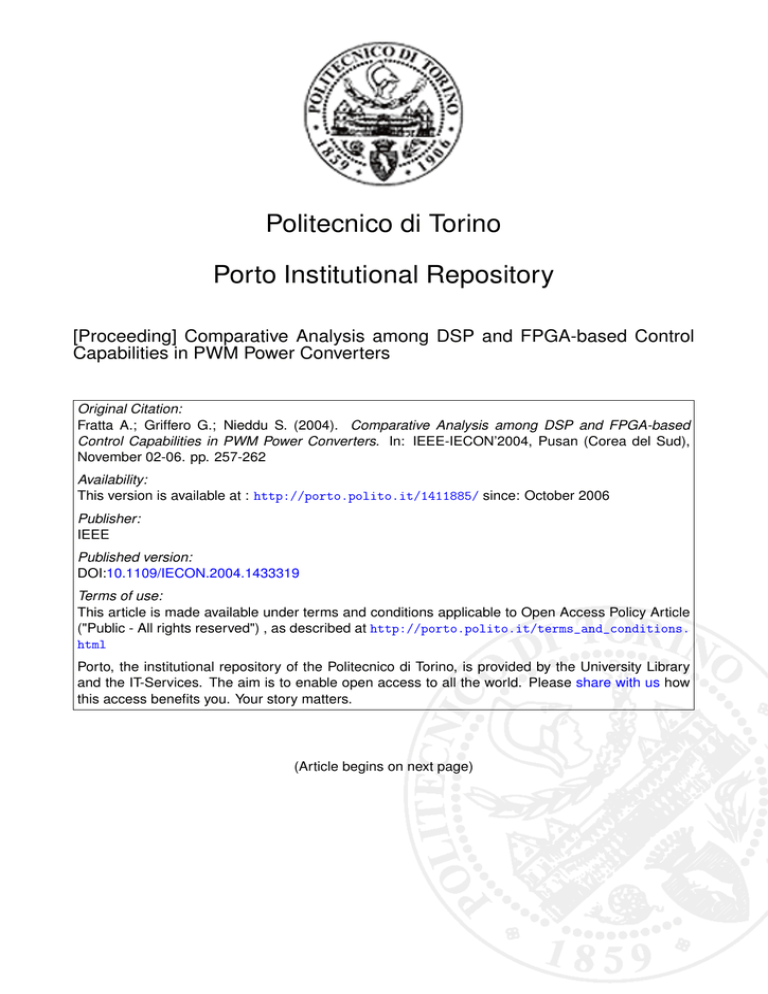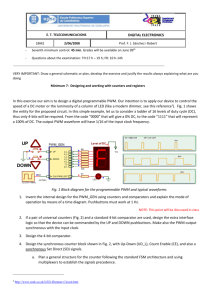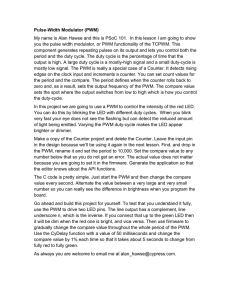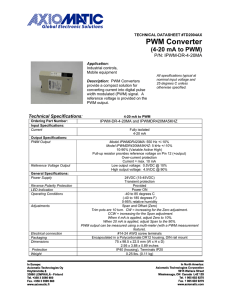
Politecnico di Torino
Porto Institutional Repository
[Proceeding] Comparative Analysis among DSP and FPGA-based Control
Capabilities in PWM Power Converters
Original Citation:
Fratta A.; Griffero G.; Nieddu S. (2004). Comparative Analysis among DSP and FPGA-based
Control Capabilities in PWM Power Converters. In: IEEE-IECON’2004, Pusan (Corea del Sud),
November 02-06. pp. 257-262
Availability:
This version is available at : http://porto.polito.it/1411885/ since: October 2006
Publisher:
IEEE
Published version:
DOI:10.1109/IECON.2004.1433319
Terms of use:
This article is made available under terms and conditions applicable to Open Access Policy Article
("Public - All rights reserved") , as described at http://porto.polito.it/terms_and_conditions.
html
Porto, the institutional repository of the Politecnico di Torino, is provided by the University Library
and the IT-Services. The aim is to enable open access to all the world. Please share with us how
this access benefits you. Your story matters.
(Article begins on next page)
-
The 30th Annual Conference of the IEEE Industrial Electronics Society, November 2 6,2004, Busan, Korea
Comparative AnaIysis among DSP and PGA-based Control Capabilities
in PWM Power Converters
A. Fratta, M ~ ~ , I E E EG., Griffero, and S . Nieddu
S.Nieddu, DipaAmento di Ingegneria Elettrica Industriale, Politecnim di Torino, C.so Duca degli
Abruzzi 24, 10129 Torino Italy, e-mail : (antonino.fta!-ta, giuseppe.griffero, stefano.nieddu)@polito.it
A. Fratta, G. Griffero,
n, REFERENCE PwM CONVERSION SYSTEM
Absfroct- P W M power converters are cIme to be mature
for standard diffusion. New FPGA technologies could now
realise at best the digital control key-points: flexible
hoper references for both physical system and control
structure are defined to compare the properties of really
different control techniques. This is strictly needed for
closed-loop digital control of PWM power converters, due to
mutual interactions between UOs time-sampling properties
and PWM ripple effects. The current loop of
Voltage-Supplied converters is here strictly considered,
since any other or outer control task is much more free from
those interactions.
performance and time to market. The paper deals with the
new digital control properties of FPGA-based techlques. On
the basis of reference Structures, a comparative analysis is
carried-aut trading-ofT dynamic performances and hn”mity
to PWM environment. All pwible sampled control or DSP
techniques are firstly analysed and compared to each other. A
breakthrough concept for FPGAs is defined, definitely solving
for P W M feedback immunity by practical over-sampling and
parallel processing while improving dynamic performances.
Simulation tests and the application of dead-beat eontrol
clearly point-out the respective djnamic properties.
ILA. PWM systems and parasitic effects.
I. INTRODUCTION
Although growing-up in application for several decades,
electric power conversion technologies are not still as
mature as needed to define production standards. This
applies particularly in P W M power applications, where
electronic power modules are close to be standard products.
In the field, the integration of digital control theory and
technology is far from, in spite of two decades of
acknowledged efforts toward standard DSP solutions.
This can be easily explained at least for medium to high
power converters, where any small control improvement
takes impact on the power converter cost and performance,
considering as a whole power modules and filtering reactive
components. As ever known, sampled digital controls
cannot compare with continuous or analog control in the
PWM environment.
Nowadays, thanks to novel gate-array integration levels
and cost, a renewed interest is devoted to FPGAs for full
integration of all control functions [1,2]. At the same time,
FPGA technology is quite mature for power conversion
applications, being adopted from more than one decade for
the integration of glue logic and auxiliary functions.
A comparative analysis between DSP and FPGA-based
control capabilities is here proposed for PWM applications,
pointing-out if and how FPGAs can reach novel theoretical
digital control limits for dynamic performances and
rejection to peculiar PWM errors [3,4,6].
A reference control structure is adopted searching for
maximum closed-Imp gain values, wanted for the lowest
parameter sensitivity. DSP control drawbacks in PWM
converters and possible breakthrough of FPGA-based
solutions are discussed. At last, the dead-beat control
concept could be adopted giving comparative evidence to the
intrinsic dynamic control properties.
State-of-the-art controlled systems are composed by
current controlled Voltage-Supplied PWM power
converters. A general power conversion structure is depicted
in Fig. I , indicating possible circuit models €orboth input
voltage source and load.
257
Mulri-resow3 load
’
TI
Fig. I Simplified sketch of simple power conversion system.
Each VS power conversion structure shows peculiar
P W M voltage harmonic content, which is also variable with
its operating duty cycle or modulation index.
Above the modulation frequency, the related current
ripple content is depending on the load impedance.
Unfortunately, the load model is hardly complex, due to
different parasitic resonances and current modes.
This particularly applies in practical loads, like electric
motors, where their inductance would be considered g o d
enough for power compatibility.
This key-point must be accurately taken into account
whenever current feedback time-samples are controlled.
At first, an ideal PWM system would be considered for
reference. Then, any other PWM effect must be evaluated for
possible rejection of unwanted related control errors.
m. REVIEW OF PwM SAMPLED CURRENT CONTROL
I1.B. Reference ideal PWM converter.
The simplest PWM system, reported in Fig. 2, can be
considered as the reference one for comparative evaluation
of digital control techniques.
As known, the single-leg structure generates on ideal
inductive load a well-defined PWM current ripple content,
the reference one for sampled control loops. This is a
triangular waveform since both the input voltage Vc and the
load e.m.f. EL can be assumed as constants or independent
variables during some switching periods at given operating
conditions.
I11.A. Drawbacks of sampled control loops.
Actually, to accomplish with regulation targets DSPs or
microcontroller devices are commonly used to control PWM
power converters. This digital environment is inherent with
the adoption of feedback time-sampling strategies.
As well known, in a ideal case as that reported in Fig. 2,
the feedback current samples must be kept only and exactly
at the triangular PWM carrier vertexes instants: there the
P W current ripple is zerc-crossing so the samples equal
the wanted mean value of current.
Unfortunately, also the reference modulation index (the
input of the PWM comparator) must be refreshed at the same
instants, avoiding duty errors or unwanted commutations.
This is why the control loop delay cannot be lower than
one-half the P W M p a i d , as the time difference between
two consecutive PWM carrier vertexes.
I
Fig. 2 Referewe single-leg PWM convena and ideal source and load
Ii.C. Reference control structure and concepts.
DrGiX4L
CMWM
"OL
A reference control scheme is proposed in Fig. 3
according to suitable PWM properties and control concepts.
The chosen current loop regulator is a simple PI. No
derivative term should be applied to feedback quantities in
such a "noisy" PWM environment that is affected by load
resonances. Derivative terms could apply only on reference
quantities (the current f in the scheme). According to the
proposed structure, dynamic terms may complete the
fedforward voltage load estimation or can realise the
dead-beat control concept.
The proposed scheme is representing the basic concepts
suitable to achieve the best performances on dynamics and
reduced sensitivity to parameter errors:
maximise the proportional gain to reduce the effects
of both additive and parametric uncertainties;
adopt accurate feed-forward compensation for
additive disturbance and dynamic term estimation;
- limit integrative term span to what strictly needed to
cover feed-forward estimation error, thus limiting
any possible wind-up and other large signal effect.
-
Fig.3 PWM closed-loopcurrent mntrol referewe structure.
258
Iligital Wtem
I
SignnlJlrer
PhyS~sJam
Rg.4 Dynamic pmpxties and drawbacksin a PW'M current loop.
In addition, with reference to the block scheme in Fig. 4,
other power conversion drawbacks may arise:
the transfer signal delays and the switch
commutation times imply a resultant time delay
between the PWM commands and the actual switch
commutations;
different turn-off and turn-on delays are foreseen and
variable with transistor temperature;
practical dead-times in inverter legs add time-delay
dependence on the sign of output current;
theZLimpedance is not purely inductive, resulting in
a PWM current ripple zerecrossing error;
more important, the stray resonances of & (and
cables) may be excited by PWM modulation
harmonics, varying with duty and dramatically
increasing sampling errors and their uncertainty
with respect to expected mean current value.
As a requirement of all, a low-pass filter is applied in
practice on the AID current signal input, trying to reduce the
related sampling errors. As a result, a further control-loop
phase margin is lost.
Sketched in Fig. 5, all single current samples are kept by
some delay (y) with respect to PWM carrier vertexes,
searching for the instant where the filtered PWM current
ripple actually crosses zero. This is the result of all
time-delays, those from PWM commands to transistor
switchings and those equivalently related to AID input filter.
However it is very difficult to set the correct sample instant,
dependently also on the current sign in inverter modules.
M.B. Overview of sampled control techniques.
The "freshest" reference value is related to the last of the
two feedback samples.
The sketch reported in Fig. 5 summarises possible
sampling instants and control techniques.
Depending on the calculation speed and clock of the
microcontroller or DSP, four different combinations are
possible. A comparative analysis is carried out to compare
performances and drawbacks.
fk.1
tk-lL2
3rd Case (DSPZ): 2 averaged samples - 2 refreshes /
P WM period.
The closed-loopbandwidth can be increased by doubling
the algorithm execution rate, holding the PWM error
rejection as in Znd case. The modulation index is refreshed
twice, that is on both positive and negative carrier peaks:
tt
4'h Case: 2 samples 2 refreshes / PWMperiod.
From theoretical p i n t of View, the best dynamic
performances are reached by double index retieshment and
not averaged sampled feedback.
This is analytically expressed by the following equations:
~
Fig. 5 Sampling techniques: A/o current samples andaveraged values:
modulation index oulput refresh instants with referenceIO PWM carrier.
With reference to the block scheme in Fig. 4, dynamic
uncertainties, parasitic load resonances and A/D signal filter
could be reported as a whole in terms of sampling error
sensitivity to residual PWM ripple or equivalent "digital
noise". On the other hand, the effects of such dynamic
non-idealities and related sampling errors are common to all
sampled control cases, thus scarcely affecting the wanted
comparative analysis of dynamic properties.
An ideal closed-Imp delay time ''Td8/' would be found
pointing-out such comparative dynamic limits. With
reference to Fig, 4, this should be dominated by the sum
between the control algorithm time-delay (evaluated from
input AID samples to output S/H refresh rate of the
modulation index) and the equivalent delay implied on the
maintenance of the PWM index (one-half the PWM index
refresh rate). All other "hardware" time delays take lower
impact while uncertain and equivalent for all control cases.
111.C. Comparison of sampled conirol techniques.
The four cases defined above are easily compared in
terms of time-delays,as reported in Table 2 . On the opposite,
their sensitivity to PWM ripple and noise can be only
qualitatively defined.
TABLE I COMPARATNE SUMMARY OF DSPS' PERFORMANCES
Is' Case {DSPI): 1 sample - I refresh / P W p e R o d .
The basic DSP control algorithm adopts the current
sample
acquired on the fa./ instant in order to generate
the modulation index value 4,
which is maintained for the
next whole PWM period (comprised between tk and rk+r).
2"dCase: 2 averagedsamples - I refresh/ PWMpen'od.
In order to improve the measurement accuracy, that is
reducing the sensitivity to PWM ripple and noise, it is
possible to better evaluate the current mean value by
averaging two consecutive current samples.
With reference to Fig. 5 sketch, the samples acquired on
the instants 4, and ia.ln are averaged to refresh the
modulation index !Ikat the time tk. The total A/D input to
S/H refresh time-delay can be equivalently associated to an
ideal feedback sample kept at the instant rk.,,+
The fourth case is somewhat the peculiar one, since it is
hardly affected by particular limit cycle at fundamental
PWM frequency. This limit cycle arises due to the P W M
ripple sensitivity amplified by high loop-gain values, since
at the limit cycle operation the zero-crossing instants of the
PWM current ripple are counter-displaced to each other in
two adjacent halves of the PWM period.
In Fig. 6 the steady-state behaviour of the modulation
index is reported for the 3"1 and 4'h cases, showing for the
latter the limit cycle superimposedto controlled mean value.
The dramaticai effect of averaged feedback samples in the
3' case avoids any limit cycle sensitivity.
259
IVB. Analysis of the ideal PWMfilter.
The Laplace transfer function of the ideal PWM filter in
(7) is formulated as follows:
The Bode diagrams ofthis ideal PWM filter are shown in
Fig. 8. T h i s transfer function equals that of the
zereorder-hold. where the maintenance time equals the
PWM ripple period.
Fig. 6 Steady-statebehaviour of DSP control loops by 2 samples and 2
refreshesf o r m modulation: 3* case(continuos line), 4* case (dashed he).
For the same cases, their rejection to digital white noise
superimposed to input AID signal is reported in Fig. 7. The
averaging properties are pointed-out also in this test,
indicating that a “quieter” closed-loop behaviour is achieved
in noisy environment.
Fig. 8 Ideal PWM filter f.d.c magnitude and phase Bode diagrams
All PWM harmonics are cancelled. Moreover the global
behaviour is like a “low-pass” filter, rejecting both external
noise and load resonant effects in response to switchings.
The phase delay is proportional to the frequency and the
equivalent time delay results:
pig. 7 Rejmtion lo white noise in the m e case5 reported in Fig. 6 .
w.TOP-PERFORMANCE
DlGlTAL FPGA-BASED
PWM
CONTROL LOOP
W.C.A FPGA-based realisation of PWMfilter.
IVA. Breakthrough concept: ideal P W f i l t e r .
In a DSP-based PWM control loop, the minimum delay
between the last sampling instant and the next index refresh
is T&?, even if the computation time could be lower than.
This constraint can be overcame by the adoption of an
alternative current measurement technique, where the
sampling instants can be freely positioned with respect to the
PWM carrier vertexes. On the other hand, a really free
samples positioning must be realised without increasing the
sensitivity to PWM errors.
The only way is to measure directly the mean value of the
current feedback, which in turn provides the ideal rejection
to any possible PWM effect.
This i s the ideal P W filter, whose continuous output,
that is the mean value-time variable of the current, can be
defined by (7):
The digital implementation of the ideal PWM filter
requires an over-sampling strategy in order to realise a
discrete calculus of (7): a sufficient number of samples must
be chosen depending on the required accuracy.
(7)
260
tk- I
tk
Fig. 9 Sanipling and filtering for FPGA conml techniques
*k-3/2
With reference to Fig. 9 the averaged current value can be
expressed as in (IO):
12
0.4
02
Similarly to the previous description, it's possible to
define a new discrete averaging operator, whose
L-transform is reported in (1 1):
"
U.D1
In Fig. IO the Bode diagrams of AVG, are reported for
m=8. It can be noted the unitary magnitude and the zero
phase delay fmfr=S, this is why the filtering action is null at
all the frequencies multiple of f l .This fact highlights the
correlation between a proper m choice and t h e maximum
peak ripple value. As an example, for the reference structure
in Fig. 2 the maximum possible error for the mean current
estimation results:
11.1
fl
i
io
.-
Fig. I I Over-sampling +external analog filter f.d.t: magnitude and phase Bcde
diagrams for m=8
W.D.Singk and double index refresh
The ideal PWM ripple filter can be implemented in a
PLD device. Moreover, thanks to the capability and
versatilityof the latest FPGAs, it's possible to implement all
the control functions into a single chip.
Considering PWM converters fur medium-high power
applications, the switching frequency is around
5lrHz+20kHz and the control tasks implemented in a FFGA
require a little percentage of TJw This means that the
computation time can be disregarded, so the total loop delay
can be minimised down to the sum between the PWM ripple
filter delay and the index maintenance time delay.
OD1
0.1
ff
<-
Is' Case (FPGAI): P W f i l t e r - 1 refresh / PWMperiod.
Considering a single index refresh per PWM period, the
index computation dependence is expressed by the
following:
1
2&Case (FPGAZ): PWMfilrer - 2 refresh/ PWMperiod.
Fig. IO Over-sampling f.d.1: magnitude and phase Bode diagrams for m=8
The discrete PWM ripple implementation can be
completed by adopting an analog filter applied to the current
signal. Several criteria can be adopted, dependently on
control performance or on high kequency rejection
requirements.
An example is reported in Fig. 11, where AVG8 is
compensated by a triple-pole filter, properly chosen in order
to set 180" phase delay atjT=I:
Doubling the index refresh frequency the index
computation is formally expressed by the followings:
V. COMPARATIVE
RESULTS
VA. Overall peq%v"ces
Thanks to this improvement, the discrete PWM filter
A VGg,/jl,prcZd
is practically equal to the ideal one up top=#.
compan'son.
In Table 2 the comparative aspects for all the previous
analysed cases are quantified. It can be noted that FPGA
solutions result better or equivalent in any comparativeterm.
261
The PWM ripple and high frequency rejection result
strongly improved by the over-sampling technique, assuring
robust regulation immunity to the non-idealities. Moreover,
thanks to the parallel processing, the very low computation
time of FFGAs allows higher dynamic performances as
expressed by the total loop delays, since in practice
<dffiifFT.
&,f&
PWM ripple
rejection
DSPl
DSF’2
LOW
GOOD
High Freq.
Analog filter
re’ection
I
FPGAl
FPGM
VERY HIGH
YES (Fig. 11)
3nT,,
ideal'oop
dela TM
Further real
3/4T,
V.3.Comparison of dynamic behaviour.
The different dynamic performances can be experienced
in terms of closed-loop reference step responses. At first a
maximum gain criterion is applied to the proportional gain.
Then the dead-beat control is realised giving perfect
evidence to the different dynamic properties.
Both the current and the PWM index waveforms are
reported in Fig. 12 showing the step response: K p is set in
each case to hold the closed-loop damping factor (45” at
cross-over fiequency); no integrative regulation is here
adopted (AV,,,d).
I index refresh
:
:
:
:
:
:
:
:
:
:
2 index reft-eshes
,
i‘
I
I*
e
I
Fig. 13 Dead-beat appliedto the same conditions as in Fig. 12.
VI. CONCLUSIONS
A comparison between DSP and FFGA-based control
capabilities in PWM power converters has been carried out.
The digital control sensitivity to sampling and control
non-idealities has been discussed. The possible
over-sampling strategies have been proposed improving
PWM ripple and high frequency rejection.
A comparative dynamic performance analysis has been
presented in terms of total closed-loop time delay.
The proposed concepts have been applied showing the
dynamic response capabilities and pointing out the
respective properties in dead-beat control.
It has k e n demonstrated how FF‘GA-based digital
control properties are tetter than DSP ones for any
comparative term.
VII. REFERENCES
[l] E. Momasson, and Y A . Chapuis, ‘‘Contributions of W A S to the
Conwl of ElectricalSystems. a Review“, IES Newskrrer, vol. 49, no. 4,
2002. pages 8-15.
[2] Shih-Limg lung. Meng-Yueh Chang. Jin-Yi Jyang, Lithia Yeh, and
Ying-Yu Tzou, “Design and Implementationof an FPGA-Based Control
1C for AC-Voltage Regulation”, IEEE Tmnsucrions on Power
Elecrronics,vol. 14, no .3. May 1999, pages 522-532.
[31 Seung-Ho Song. Jong-Woo Choi. and Sung-IG SUI, ‘Current
Measurements in Digitally Conmiled AC Drives”, IEEE Industry
AppIicutions Magazine, JulylAugust 2000.pages 5 1-62.
[4] Angel de Castro, f’ablo Zumel, Oscar Gmia, Teresa Riesgo, and Javier
Uceda, “Concumnt and Simple Digital Controller of an AUWC
Converter With Power Factor Correction Based on an FPGA”,IEEE
Trunsacfionson Power Elecfronicr,vol. 18. no. I , January 2003, pages
Fig. 12 Closed loop step response with proportional only regulator.
lo=VCT,&
Eflc=O.ZS; a11 p.u. variables (O.l/div).
As a consequence of the total loop delay, the case DSPl
have the slowest response; on the opposite, the FPGA2 one is
characterised by the best control performance. For the same
reason, since the loop delays of the DSPZ and the FFGA1
cases are equal, their responses are very close to each other.
A dead-beat control concept is applied, according to Fig.
3 control structure, to the control loops reported in Fig 12.
The resulting responses are reported in Fig. 13, pointing
out the different position and width of the single time slot
theoretically needed to get the target.
334-343.
A. Fratta, P. Guglielmi. G.M.Fellegrino. F. h p i n o , and F. Villara.
“Efficient Modulation Tecnique and NL Conbol of H-bridge Bwst
Convertas for Batrery-SuppliedAC Motor Drives”, IEEE lnternarionol
Symposium un Indusrrial Elecwonics (ISIE 99)?1999, pages 806-812.
[61 Angel V. Pererchev, and Seth R. Sanders, “QuantizationResolution and
Limit Cycling in Digitally Conrolled PWM Convene“’, IEEE
Tmnsrrcfionson Power Hecfrunics, vol. L8.no. I , January 2003, pages
[5]
301-308.
262







